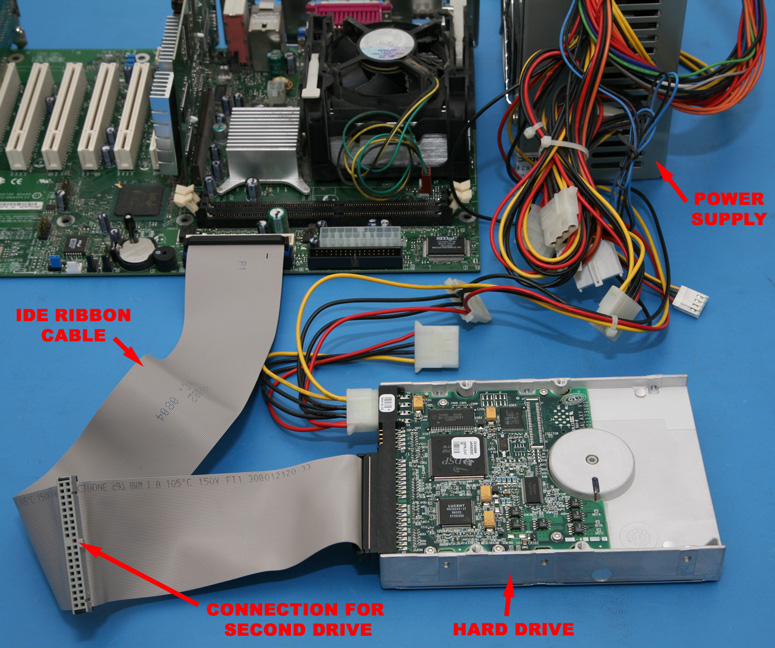
|
An IO device always consists of 2 parts:

- The actual IO device itself (that's the part you would
"recognize" as an IO device, e.g., the disk, the mouse,
the terminal, the scanner, etc).
- The interface, - that's the part of the IO device that you do not usually see, unless you have opened your computer. It consists of a circuit board containing chips and other electrical components
Example:

Can you see the circuit board inside the hard drive ???? That's the interface !!!
The hard drive consist of:
- The hard drive (is some platters hidden inside the metal enclosure)
- The interface that connects the hard drive to the System Bus (= the circuit board in the photo)
|
|
- Parallel interfaces (or parallel ports - typically used to control printer and scanners)
- Serial interfaces (typically used to control slower devices like mouse, modem, etc)
- USB (Universal Serial Bus) interfaces. (Higher speed serial device, is even faster than the traditional parallel port. Can even handle 11 Mbps wireless network connections. Very commonly used to control any type of slow to medium speed IO devices.)
- Firewire interfaces - very high speed serial device.
Since the most common interfaces are already on the motherboard, it is no wonder that you will rarely see an interface card.
You can easily tell when the interface of the IO device is already included inside the computer (motherboard) or not: when you buy an IO device and you don't have to open your computer to install the IO device, then the interface is included inside the computer (motherboard).
One example that you will see the actual interface card is when you installs a Network Interface Card or "NIC" (but networking capability is becoming more and more popular and a NIC may eventually be included also). Another example is when you install a SCSI card in your PC to allow your PC to use higher speed SCSI hard disks.
Low end PC usually have 2 IDE controllers and each IDE controller can control 2 IDE devices such as hard drives and CD ROMS.
- Specifically: the interface circuit contains registers that the CPU can read and write.
|
|
In particular, there is always a command register to which the CPU can write a command code. The command code will trigger the circuitry to make the IO device perform the specified operation.
- Hardware (electronics) to control the actual IO device
- Registers that can be read (e.g., status rgeister) and/or written (e.g., command register) by the CPU (through the system bus).
|
|

Note:
- The registers in an
IO device are
simply memory cells
(just like the memory cells found in the
memory device !!!)
- The only difference is the content of these registers can trigger the IO device hard ware to perform certain operation !!!
|
|
You have already seen how CPU communicates with memory... For example, if the CPU wants to read a memory location:
- CPU sends out address, MREQ and READ request
- CPU waits until the memory removed the WAIT signal
- When the WAIT signal is off (memory data is ready), CPU copies the data on the databus into MBR and move it to its final destination (usually a register)
- All this has been explained here: click here and click here
- Example: printer

How to print the letter 'A':
- The CPU write ASCII code of
'A' to the
data register of the
printer:

- Then, the
CPU write the
PRINT into the
command register of the
printer:

- In response, the
printer sets its
status register to
not-ready and
starts printing the charactr:

Printing a character will take many mmilli seconds !!!
In the mean time, the CPU cannot send more character to be printed --- the printer will not print them.
(I am assuming a printer without buffering.
Even if the printer has a buffer, the buffer can become full and then the printer will drop every character sent to it...)
The CPU must wait until the printer changes its status register to ready before the CPU can send another character for printing !!!
- The CPU write ASCII code of
'A' to the
data register of the
printer:
- CPU sends out address of the keyboard and a READ request
- CPU waits until the keyborad removed the WAIT signal
- When the WAIT signal is off (keyboard data is ready on the databus), CPU copies the data on the databus into MBR and move it to its final destination (usually a register)
The reason why we can make the CPU wait on a transfer operation to memory is because the memory is very fast - finishes in about 50 nsec.
You do not want to make the CPU wait on a transfer operation to an IO device is because it takes many milli-seconds or even seconds in case of a keyboard, for the data to become ready. A milli-second is almost an eternity to the CPU: in a single milli-sec, the CPU can execute tens of thousands of instructions.
- Addressing
the IO device: how to identify an IO device
- Data Transfer:
how to transfer data from IO device
to memory
(not to the CPU !, the memory is the storage area !) and vice versa
- Synchronization: you will see that a program that performs an IO operation will not be able to proceed with its execution. That program must release the control of the CPU and reclaim it when its data transfer operation has finished. The reclaiming of the CPU is a form of synchronization
|
|
These 3 functions will be discussed next...